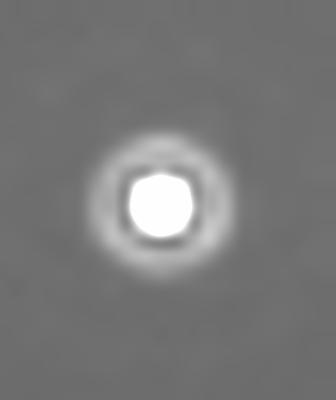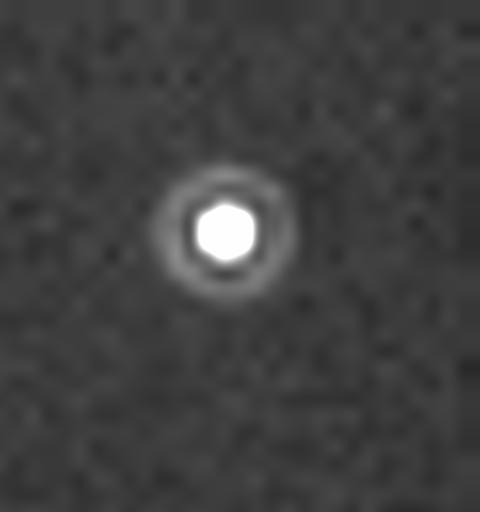
PSF for FWD Slow scan

PSF for REV Slow scan
Principal:
Deputy:
Analyst:
AORKEYS:
Last Updated:
| AORID |
Leg
Length (degrees) |
#
Legs |
Cross-scan
Offset (arcsec) FWD -> REV, REV->FWD |
| 0007427072 |
1.5 |
1 |
0 |
| 0007427328 |
0.5 |
2 |
35 |
| 0007427584 |
0.5 |
2 |
148 (map center offset -3600") |
| 0007427840 |
0.5 |
2 |
302 |
| 0007428096 |
6.0 |
1 |
0 |
| 0007428352 |
0.5 |
5 |
276,111 |
| 0008149614 |
0.5 |
2 |
0 |
 PSF for FWD Slow scan |
 PSF for REV Slow scan |
| OMEGA
(millarcsec/sec)/RAMPDIR (0=FWD, 1=REV) |
DCENUM |
Time
(real seconds) |
Boresight
Motion (arcsec) |
Predicted
SCANABS (coarse DAC) |
CSMM
Offset on sky (arcsec) |
Offset
from DCE0 (") |
Offset
from Prior DCE (") |
| 2580/0 |
0 |
0 |
0 |
2001.88 |
0 |
0 |
0 |
| 2580/0 |
1 |
11.025 |
28.444 |
2024.88 |
-12.812 |
15.632 |
15.633 |
| 2580/0 |
2 |
22.05 |
56.889 |
1991.62 |
5.709 |
62.598 |
46.966 |
| 2580/0 |
3 |
33.075 |
85.333 |
2014.62 |
-7.102 |
78.231 |
15.634 |
| 2580/0 |
4 |
44.1 |
113.778 |
1995.125 |
11.419 |
125.197 |
46.966 |
| 2580/0 |
5 |
55.125 |
142.222 |
2014.62 |
-1.392 |
140.831 |
15.634 |
| 2580/0 |
6 |
66.15 |
170.667 |
1971.12 |
17.129 |
187.796 |
46.966 |
| 2580/0 |
7 |
77.125 |
199.111 |
1994.12 |
4.317 |
203.429 |
15.633 |
| 2580/0 |
8 |
88.2 |
227.556 |
1960.88 |
22.84 |
250.396 |
46.967 |
| 2580/0 |
9 |
99.225 |
256.000 |
1983.88 |
10.026 |
266.026 |
15.631 |
| 2580/0 |
10 |
110.25 |
284.445 |
1950.62 |
28.553 |
312.890 |
46.972 |
| 2580/0 |
11 |
21.275 |
312.889 |
2001.88 |
0 | 312.890 |
-0.109 |
| 2580/1 |
0 |
0 |
0 |
2012.12 |
0 |
0 |
0 |
| 2580/1 | 1 |
-11.025 |
-24.444 |
1989.12 |
12.811 |
-15.634 |
-15.634 |
| 2580/1 |
2 |
-22.05 |
-56.889 |
2022.38 |
-5.71 |
-62.599 |
-46.966 |
| 2580/1 |
3 |
-33.075 |
-85.333 |
1999.38 |
7.102 |
-78.231 |
-15.633 |
| 2580/1 |
4 |
-44.1 |
-113.778 |
2032.62 |
-11.42 |
-125.198 |
-46.966 |
| 2580/1 |
5 |
-55.125 |
-142.222 |
2009.62 |
1.393 |
-140.830 |
-15.632 |
| 2580/1 |
6 |
-66.15 |
-170.667 |
2042.99 |
-17.133 |
-187.8 |
-46.971 |
| 2580/1 |
7 |
-77.175 |
-199.111 |
2019.99 |
-4.317 |
-203.429 |
-15.629 |
| 2580/1 |
8 |
-88.2 |
-227.556 |
2053.12 |
-22.847 |
-250.403 |
-46.974 |
| 2580/1 |
9 |
-99.225 |
-256.000 |
2030.12 |
-10.027 |
-266.023 |
-15.625 |
| 2580/1 |
10 |
-110.25 |
-284.445 |
2063.38 |
-28.563 |
-313.008 |
-46.981 |
| 2580/1 |
11 |
-121.275 |
-312.889 |
2012.12 |
0 |
-312.889 |
0.119 |
| FWD
Scan Offset from Prior DCE (24um centroids, arcsec) |
REV
Scan Offset from Prior DCE (24um centroids, arcsec) |
| 15.85 |
-46.03 |
| 47.53 |
-15.44 |
| 15.70 |
-46.63 |
| 46.98 |
-15.65 |
| 0.158 | -47.16 |
| 15.56 |
-0.096 |
| 46.44 | -15.64 |
| 15.40 |
-47.74 |

